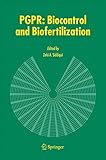PGPR: Biocontrol and Biofertilization / edited by Zaki A. Siddiqui.
Tipo de material: TextoEditor: Dordrecht : Springer Netherlands, 2006Descripción: xiii, 318 páginas recurso en líneaTipo de contenido:
TextoEditor: Dordrecht : Springer Netherlands, 2006Descripción: xiii, 318 páginas recurso en líneaTipo de contenido: - texto
- computadora
- recurso en línea
- 9781402041525
- S1-S972
Springer eBooks
Ecology of Plant Growth Promoting Rhizobacteria -- Induced Systemic Resistance as a Mechanism of Disease Suppression by Rhizobacteria -- Biosynthesis of Antibiotics by PGPR and its Relation in Biocontrol of Plant Diseases -- PGPR: Prospective Biocontrol Agents of Plant Pathogens -- Bacterial Biofertilizers -- Role of Cytokinins in Plant Growth Promotion by Rhizosphere Bacteria -- Plant Growth Promoting Rhizobacteria: Potential Green Alternative for Plant Productivity -- Visualization of Interactions of Microbial Biocontrol Agents and Phytopathogenic Fungus Fusarium Oxysporum F. Sp. Radicis-Lycopersici on Tomato Roots -- A Proteomics Perspective on Biocontrol and Plant Defense Mechanism -- Plant Growth Promoting Rhizobacteria Formulations and its Scope in Commercialization for the Management of Pests and Diseases -- Biocontrol of Plant Diseases by Genetically Modified Microorganisms: Current Status and Future Prospects.
PGPR have gained world wide importance and acceptance for agricultural benefits. These microorganisms are the potential tools for sustainable agriculture and the trend for the future. Scientific researches involve multidisciplinary approaches to understand adaptation of PGPR to the rhizosphere, mechanisms of root colonization, effects on plant physiology and growth, biofertilization, induced systemic resistance, biocontrol of plant pathogens, production of determinants etc. Biodiversity of PGPR and mechanisms of action for the different groups: diazotrophs, bacilli, pseudomonads, and rhizobia are shown. Effects of physical, chemical and biological factors on root colonization and the proteomics perspective on biocontrol and plant defence mechanism is discussed. Visualization of interactions of pathogens and biocontrol agents on plant roots using autofluorescent protein markers has provided more understanding of biocontrol process. Commercial formulations and field applications of PGPR are detailed.
Para consulta fuera de la UANL se requiere clave de acceso remoto.


